DO-IT News May 2018

Volume 26, Issue 3
Below are the articles of the DO-IT News May 2018 newsletter. These articles can also be seen all on one page at the Full Newsletter option.
Meet the 2018 Scholars!
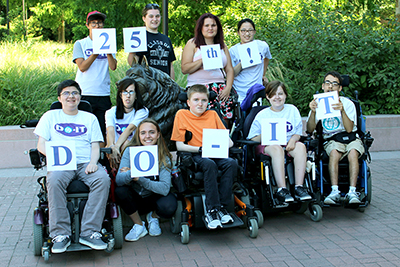
This summer, DO-IT will host its twenty-sixth annual Summer Study program for DO-IT Scholars, providing participants the opportunity to experience life on a college campus and explore challenging academic and career fields such as those in science, engineering, and computing. Primary funding for the Scholars program is provided by Washington State. Visit our website for more information.
I am pleased to introduce to you the 2018 Scholars:
Abby attends Seattle Academy where she enjoys classes in math and chemistry. She hopes to be an entrepreneur and venture capitalist after majoring in economics. She has dyslexia, attention deficit hyperactivity disorder, and nut allergies.
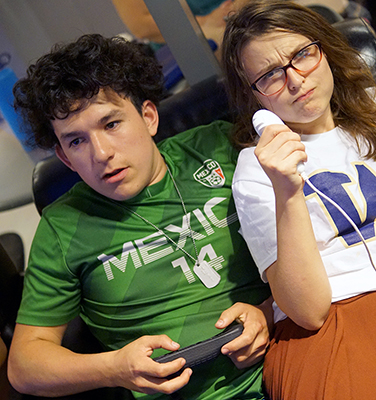
Cheyann enjoys studying music and Spanish at the Washington State School for the Blind. She is interested in computer science. She is from Port Orchard.
Dean works as a sound tech at his local theater providing audio support for dramatic productions of all sorts. He hopes to pursue a career as a sound designer or audio engineer after college. He has an autism spectrum disorder. His favorite classes at Liberty Bell Junior-Senior High School are English and math.
Dillen plans to get a college degree in computer science or math, which are his favorite classes at Mt. Si High School. He lives in Snoqualmie. He has cerebral palsy. He recently participated in the TEALS (Technology Education and Literacy in Schools) event at Microsoft.
Finn lives in Bellingham and attends Sehome High School. His classes in history and science are his favorites. He has a few careers in mind for after college—teaching social studies or history, becoming a comic writer, or illustrating graphic novels. He has nemaline myopathy.
Ian attends Juanita High School and lives in Kirkland. He is Deaf and wears bilateral cochlear implants. He hopes to get his Ph.D. in either auto or aerospace engineering. He enjoys his math and science classes.
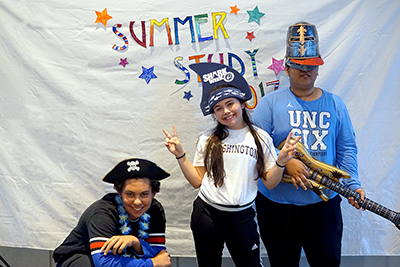
Isabel hopes to pursue a career as a mental health counselor or sports psychologist after college. She attends Port Townsend High School where she enjoys studying English and science. She has dyslexia.
Jeremy is interested in science, chemistry, and physics at Lynden Christian High School. These interests will help him pursue a major in analytical chemistry in college. He is from Russia but lives in Bellingham. He has autism and epilepsy.
Joshua attends the International School and lives in Bellevue. His favorite classes are science and history. He has arthrogryposis and scoliosis. He hopes to major in aerospace engineering.
Kade enjoys his classes in agricultural science and literature. He has dyslexia and uses Bookshare and Audible to pursue his love of reading and literature. He hopes to either go in to the field of business or become an author. He attends Stanwood High School.
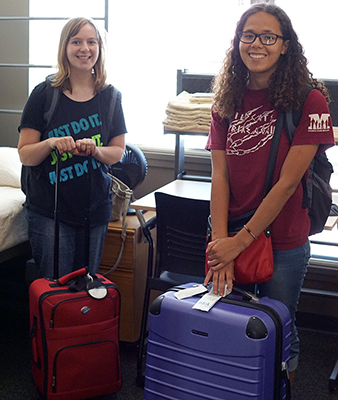
Maribel attends Omak High School where she will be the student treasurer next year. She enjoys science and math classes. She has cerebral palsy and learning disabilities.
Nathan attends Edmonds-Woodway High School and lives in Seattle. He hopes to be an architect. He enjoys his classes in English and history. He has Deafness.
Oksana enjoys her classes in IT and history at Lindbergh High School. She lives in Renton. She has spina bifida and scoliosis.
Sandra attends Zillah High School where she enjoys studying language arts and math. She hopes to be a counselor. She has a learning disability.
Torin attends Summit Sierra High School and lives in Seattle. They hope to be a novelist, though they plan on getting their teaching certificate to teach between publishing. Their favorite classes are literature, world history, and physics. Torin experiences the after effects of cancer treatment.
Staff Profile: Jungsoo Kim
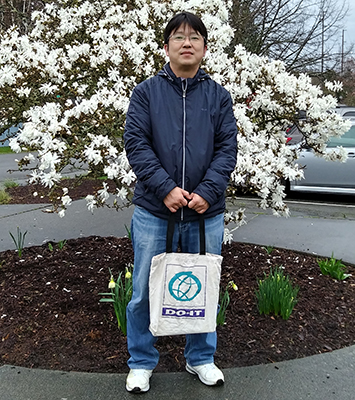
Hello, my name is Jungsoo Kim. I am a visiting scholar from South Korea at the DO-IT Center. I am researching universal design and the special education system here in the US, as well as seeing how DO-IT operates.
I received my bachelor’s degree in special education from Dankook University, South Korea and I earned my master’s degree in special physical education from Korea National Sport University, with my dissertation entitled An Action Research on the Application of Interactive Video Games on Students with Disabilities. I then earned my doctoral degree at Dankook University, focusing on the development and application of science education programs based on augmented reality for people with disabilities. My research interests are in educational technology, assistive technology, and educational content for children with disabilities.
I have taught children with disabilities for about 10 years in private and public special schools. I became an educational researcher in 2013. I worked at the Information Support Division of the National Institute of Special Education (NISE) for about four years before transferring to the Special Education Policy Division of the Ministry of Education, Korea. More specifically, my major role at NISE was to host the National Information Competition for Students with Disabilities and the National E-Sports Competition for Students with Disabilities, evaluate web accessibility at special education schools, and develop mobile applications for learning. My role at the Ministry of Education is to manage the recruitment size for special school teachers, protect the rights of disabled students, provide online video training courses for students with health impairments, and manage support projects for young children.
Dr. Sheryl Burgstahler and DO-IT are widely known to NISE for their incredible commitment to empowering people with disabilities through technology and education. In South Korea there is a growing interest in improving the distribution system for existing assistive technologies, as well as a wider implementation of universal design. DO-IT is a good role model. During my stay here, I would like learn new ideas to help improve the special education in Korea.
I am staying here in the US with my family. We arrived in the US in late February. We are enjoying the beautiful sceneries and the cultural diversity around Seattle. I am very grateful for having the opportunity to spend some time exploring Seattle and recharging my batteries.
Tech Tips: Sonocent
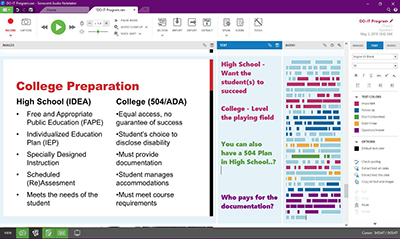
Looking for a new note taking program? I would like to recommend Sonocent. I have been using Sonocent, provided by DO-IT, for about two years and it has been a key to my college success.
Sonocent is a computer and mobile program that allows you to record the audio of a lecture, meeting, or presentation and sync that audio up with typed notes, as well as images or slides.
The audio recording is split into “chunks” by the natural pauses in a presenter’s speech pattern. These individual chunks can be color coded into categories, such as “important,” “do not understand,” and “on exam.” You can also color code the text notes into those same categories, and all the color categories are customizable.
Audio chunks can also be rearranged, deleted, or copied, either individually or in groups. This allows you to concentrate a whole quarter-long class into a few hours of just the most important terms, or split up your studying by concepts, rather than the original order of the slides.
When it comes time to play back the audio, Sonocent allows you to adjust the playback speed and pitch of the speaker. I personally have difficulties understanding mid-range voices, so I turn the pitch way up to understand my professor better. You can also set the playback to be stereo or mono.
Sonocent is an amazing program full of rich features, and has been a life saver for me when it came to taking notes in class. I wish I had access to Sonocent earlier, as it would have been great in high school as well. I plan to continue using this program throughout law school and into my career. If you want to learn more or obtain the 30 day free trial, check out Sonocent's website.
Keep in mind that to audio record a class or lecture you need to ask permission from your instructor or get an approved disability-related accommodation from your disability resources office. Without that accommodation, many instructors will not allow their presentations to be recorded.
CRA Graduate Cohort Workshop
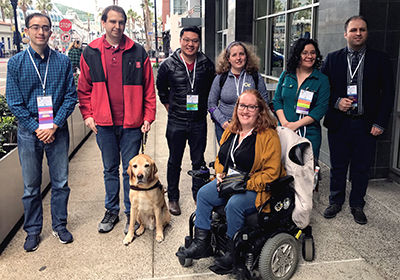
In March of 2018, I attended the Computing Research Association (CRA) Graduate Cohort Workshop for Underrepresented Minorities and Persons with Disabilities in San Diego, California. AccessComputing was one of the workshop’s sponsors.
The workshop aimed to increase the ranks of underrepresented minorities and persons with disabilities in computing research by allowing graduate students to meet mentors and build nationwide communities that can persist through their graduate studies and beyond.
Having the opportunity to go to San Diego for the CRA Graduate Cohort was a truly amazing experience. The inclusive environment and the commitment to ensure an accessible environment were phenomenal and far beyond most of the conferences, workshops, and academic events I have participated in previously.
Throughout the event I made meaningful connections with numerous peers and leaders in my specific research focus. The advice and guidance that I received was incredibly helpful. They provided me with new information that affects my graduate school, research, and conference focuses.
Additionally, the information provided within the workshop sessions was geared to my graduate timeline. Participants were allowed to pick one of three tracks based on where they were in their grad program, as well as fluctuate between sessions of all three. These tracks allowed you to understand the populations the particular workshops were targeting. All information provided within the sessions were presented in accessible formats.
I highly recommend that graduate students who are a minority or underrepresented within the computing field attend the CRA Graduate Cohort. The experience allows for graduate students at any stage of their graduate studies to participate in useful information sessions, build community, and grow their professional network.
Twenty Five Ways DO-IT is Changing the World
To commemorate DO-IT’s 25th anniversary, staff members and mentors recently sat down to identify ways that DO-IT is attempting to make the world more welcoming and accessible for people with disabilities, which included
- promoting inclusive learning environments;
- identifying future leaders with disabilities;
- creating access to empowering technology;
- encouraging people to caption videos;
- connecting individuals with disabilities to mentors; and
- advocating for accessible websites, documents, and software.
The list includes specific examples about how people can join these efforts. To learn more, visit “25 Ways DO-IT is Changing the World” in the DO-IT Retrospective. We look forward to another 25 years of engaging students, job-seekers, educators, administrators, service providers, employers, policy-makers, and other stakeholders in these efforts.
IT Accessibility Specialist Hadi Rangin Wins Outstanding Staff Award
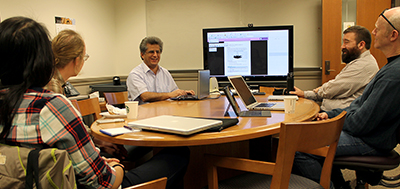
Hadi Rangin, IT Accessibility Specialist within UW-IT, is usually found anywhere from giving individual support on the accessibility of a small department’s website to advising the creators of the learning management system used across the entire campus on the necessary requirements to meet ADA standards. Most technologies used on campus have, in some way, been influenced by his work.
His contributions were recognized by the University of Washington (UW) Professional Staff Organization with the Bob Roseth Outstanding Staff Award. This award celebrates the impact a staff member makes on campus and beyond, while going above expectations to achieve results. Hadi definitely embodies this mentality, as he is always pushing to get results, both from those within UW and the vendors he works with on a regular basis.
Here is an excerpt from his nomination letter: “Through his work, Hadi is helping to make the campus a more welcoming and inclusive environment that allows equal access to technology. His efforts allow people with disabilities equal access to technology for their work and studies. He showcases the innovation that people with disabilities can bring to any project.”
We celebrated Hadi on April 10th in the UW Club. Congratulations to Hadi for making UW the best it can be!
Transitioning to College: Resources for Students, Parents, and Educators
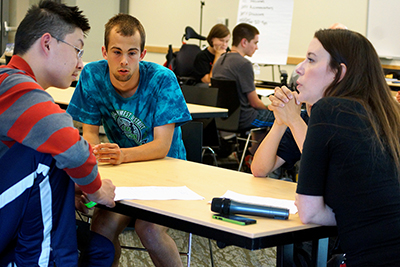
Special education services provided by the Individuals with Disabilities Education Act (IDEA) end with high school graduation, but disability-related services continue to be provided under Section 504 of the Rehabilitation Act of 1973 and the Americans with Disabilities Act. Understanding how these laws apply at college is an important piece of the puzzle for transitioning students. The U.S. Department of Education’s Office of Civil Rights website provides a great place to start:
- Students can consult Students with Disabilities Preparing for Postsecondary Education: Know Your Rights and Responsibilities
- Parents can read Dear Parent Letter
- Educators can read Transition of Students With Disabilities To Postsecondary Education: A Guide for High School Educators
Introducing the AccessComputing Resume Database
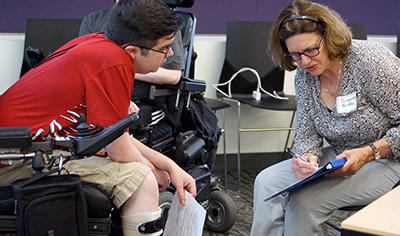
In the October 2017 edition of AccessComputing News, we announced the launch of our Resume Database. The Resume Database was created to help employers connect with individuals with disabilities in computing fields, such as computer science and information technology. Students and recent graduates who have disabilities can use the Resume Database to complete an online profile and upload their resume. Then, employers can search the database to locate potential interns and employees with disabilities who match their specific needs.
To date, 82 applicants have logged into the system to complete profiles and upload resumes, and 12 industry partners have created accounts in order to search for possible candidates. 497 profiles have been viewed and 19 resumes have been downloaded.
In order for students to use the Resume Database, they must first join the AccessComputing Team, a community of high school and college students with disabilities who are interested in computing fields. Team membership has many benefits, including access to support staff and mentors and opportunities to engage in electronic mentoring, work-based learning, and other experiences that enhance college and career success in computing fields. Project staff help team members to locate paid internships and other work and research opportunities as they transition to and succeed in college, graduate school, and employment. For additional information or to apply, complete an AccessComputing Team Application.
In order for employers to access the Resume Database, they must be an AccessComputing Industry Partner. For additional information or to become an Partner, please see our Industry Partners web page.
AccessCSforAll Participating in Video Showcase
For the fourth year, AccessCSforAll will participate in the STEM for All Video Showcase. The Showcase, which runs from May 14-21 will highlight work being done by federally-funded programs to transform STEM education. This year, the AccessCSforAll submission will bring attention to including students with disabilities in K-12 computer science education by highlighting a blind student programming a robot using Blocks4All. Blocks4All, developed by UW (University of Washington) CSE (computer science and engineering) graduate student Lauren Milne, explores techniques to make block-based programming accessible to students who are blind.
Last year’s AccessCSforAll video Quorum: An Accessible Programming Language won a Facilitator’s Choice award.
AccessComputing Team Member Profile: Shuxu "Sophie" Tian
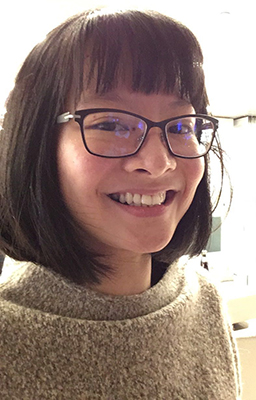
I attended Gallaudet University, a school for the Deaf and hard of hearing located in Washington, DC. After graduating from Gallaudet, I moved to Seattle for back-to-back internships at Microsoft as a software engineer and began attending the UW computer science program for a post-baccalaureate degree.
One of my projects is PaintSound, which is a software application on the Microsoft HoloLens platform that can detect sources of sounds and then visualize them. This project is an extension of a previous app that I worked on at Microsoft named EyeHear. EyeHear converts spoken English into captions on HoloLens in order to enhance Deaf and hard of hearing users’ experience in group settings.
PaintSound, in contrast, doesn’t perform language translation. Rather, it finds the source of sounds, shows it to the user, and visualizes the sounds in a creative way. In our most recent prototype, PaintSound shows darker colors such as blue or purple for low pitches, and brighter colors such as red and orange for higher pitches.
I created this application with a group of interns in the One Week Hackathon at Microsoft. Some of my friends are born deaf, and assistive technologies such as cochlear implants or hearing aids cannot provide a full sense of the array of sounds in their environment. Having lost my own hearing at age 13, I have missed the rich nuance of sounds. I wanted to spread the idea that what’s often missed with deafness is not only auditory information but also the enjoyable melody of life. It’s important that we as deaf people gain equal access to the world. I chose to work on this project because I am very passionate about accessibility—my dream is to empower people with disabilities around the globe, and I believe that computer science is the tool to accomplish that dream.
Computer science is not only fun; it has helped solve so many real world problems in communication, productivity, and health that we take for granted today. It’s thrilling to know the kind of impact I could make.
An Exciting 2018 CSUN Conference
Nine DO-IT participants from across the US attended the 33rd annual International Technology and Persons with Disabilities Conference (CSUN). The students attended sessions, helped at the exhibit booth, explored offered resources, and networked with both professionals and one another. Many of them knew each other from email but had never met in person. Their highlights were attending networking events hosted by Microsoft, Google, and Deque. They made a lot of valuable connections.
At the opening keynote, AccessComputing and AccessCSforAll PI Richard Ladner received the Strache Leadership Award. Each year the Center on Disabilities recognizes a leader in our field who has made a major impact in education and research. Ladner’s work has focused in creating and evaluating technologies to help make the lives of people with disabilities better. He is currently working on various projects for both AccessComputing and AccessCSforAll.
Also during the conference, Terrill Thompson presented the session “Media Player Accessibility: Insights from Interviews and Focus Groups,” where he described the lessons learned from interviews and focus groups conducted at CSUN in 2017 to better understand how persons with disabilities use video players.
The numerous sessions and wide array of resources offered left the students with a packed schedule and many assets to bring back with them. The students left excited about future technologies and inclusion.
To learn more about this year’s event or subscribe to the Center on Disabilities’ mailing list, visit their website.
AccessComputing PI Richard Ladner Wins Strache Leadership Award
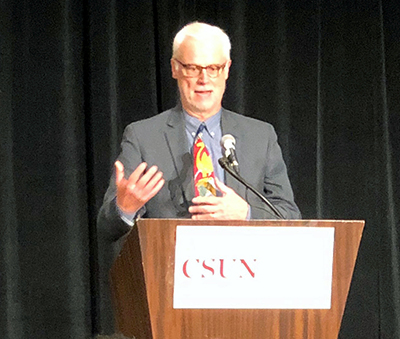
AccessComputing and AccessCSforAll PI Richard Ladner was recently honored with the Strache Leadership Award for his work in accessibility education and research. He got his award from the Center on Disabilities at California State University, Northridge (CSUN), which hosts the CSUN Assistive Technology Conference each year—the largest international conference to focus on assistive technology.
Ladner has been a leading researcher in the field of accessibility for over thirty years, and his work—both through our programs and in his teaching and research at the University of Washington—has increased access for people with disabilities to technology and computing careers. Ladner has been recognized numerous times throughout the years for all work he has done in the field of accessibility, winning the 2004 Presidential Award for Excellence in Science, Mathematics and Engineering Mentoring (PAESMEM), the 2008 Computing Research Association A. Nico Habermann Award, and the 2016 ACM SIGACCESS Award for Outstanding Contributions to Computing and Accessibility.
DO-IT Director Sheryl Burgstahler has also won the Strache Leadership Award, being recognized in 2012 for her leadership in promoting college success for students with disabilities and the universal design of instruction, technology, and services in higher education.
Learn more about his award and his background from the UW Allen School Newsletter or watch his acceptance of the award starting at 1:08 of the CSUN conference keynote. Congratulations, Richard!
How Do You Travel While Disabled?
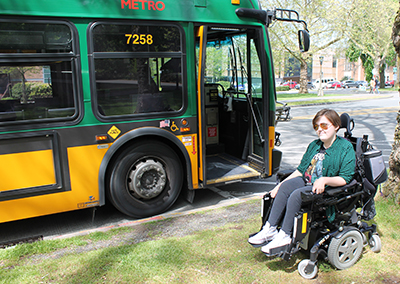
Most folks enjoy traveling and the chance to explore new places, but I felt beyond nervous and totally unprepared for a recent trip from Seattle to Boston. What exactly does traveling long-distance look like if you have a disability?
I use a power wheelchair full time and hadn't flown in eight years. My last flying experience left my chair in shambles and malfunctioning from being mishandled during loading and unloading. To prevent this in the future, I compiled a list of options to consider while traveling that I and others with disabilities can use.
My main concern is keeping my chair in one piece. An option might be to travel by land instead of flying by taking a train or making a road trip. However, each has its own issues; these options take much longer and may cost more as you will need to find accessible hotels and pay for gas. Amtrak is fairly accessible, but has limited sleeping cars and bathroom options.
In my instance, I only had a week to get to Boston. Since I had to fly, I sought out other solutions. One, albeit at a price, is to rent medical equipment in the city you plan to stay in. Boston Medical Supplies could supply hoyer lifts, manual chairs, and even things like oxygen tanks, bipaps, and other assistive mobility devices. I also found a company that rented power chairs and offered to have it waiting at the airport. Although borrowing equipment for some may be an option, these were all generic pieces of equipment; if you use specialized hand controls, seats, or seat belts, renting a chair might not be ideal.
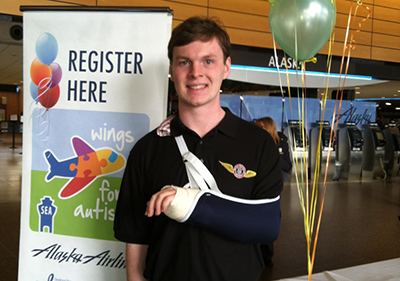
Transportation can be another issue once you arrive at your destination. Some cities have bus routes or light rail, but be sure to check where and when they run. Some cities have accessible taxi options; in Seattle, the Yellow Cab Taxi app gives the option to pick a wheelchair accessible van. However, depending on traffic, they may take a long time to arrive and tend to be expensive. You may also choose to rent your own accessible van. These are usually available in most big city in the US. These cars can be ready for you at an airport, but can be pricey—some places run close to $200 a day for an accessible vehicle.
Flying may also cause anxiety. There are programs available that help prepare participants for flight, such as the Wings for Autism program. Those who identify as autistic can sign up to practice boarding and finding a seat, all while talking to crew members about any concerns. Flying can become more familiar this way. Ambassador Ryan wrote about his experience with Wings for Autism on The Arc of King County blog. If Wings for Autism doesn't work for you, there are other programs available, such as the Fear of Flying Clinic.
Even though traveling while disabled is no small task, dedicating the time to finding the right methods and tools will help ensure a more successful trip.
Able Player 3.1 Released, Research Paper Published
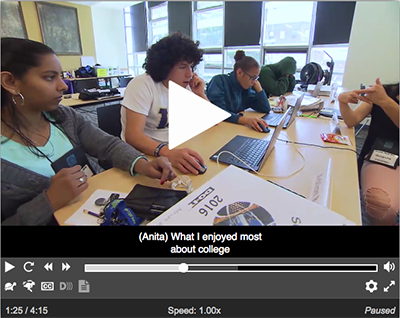
The release of Able Player 3.1 was announced at the CSUN 2018 International Technology and Persons with Disabilities Conference in San Diego. Able Player is an accessible online open-source media player designed and developed with support from AccessComputing. It features high contrast buttons and controls that can easily be operated by screen reader users, keyboard users (without a mouse), and speech input users.
It is the only media player that supports all five kinds of <track> elements, introduced in HTML5 to provide a means of synchronizing text with media during playback. The five kinds of <track> elements are captions, subtitles, descriptions (which can be read aloud at appropriate times by screen readers), chapters (which add structure to videos, enabling users to jump to the start of particular sections), and metadata (enabling interactive features in videos such as clickable hot spots). It also parses the content from chapters, descriptions, and captions (or subtitles) tracks and reassembles them into an interactive transcript. The content of the transcript is highlighted during video playback, and users can click anywhere in the transcript to play the video at that point. Able Player also features “slower” and “faster” buttons that enable users to control playback rate, and supports sign language in a supplemental video, synchronized with the main video.
Version 3.1 includes a number of bug fixes and enhancements. Perhaps the most noteworthy new feature is support for the playsinline attribute, which instructs mobile devices to play the video within its original context in the web page, rather than load the video into the device’s native video player. In prior versions this had been a problem particularly with iPhones. When a user tapped the play button in Able Player, the video would be loaded in the iOS video player. Users could watch the video there, and access captions if enabled in their accessibility settings, but it was otherwise impossible to access all the other features of Able Player that make video interactive and accessible.
Resource Highlight
Equal Access: Universal Design of Your Presentation
Do you deliver presentations to a wide variety of audiences? It is important to remember that content should be accessible to all, including those who may have sensory impairments. Check out a series of guidelines in Equal Access: Universal Design of Your Presentation.
Universal Design in Higher Education: Promising Practices
In DO-IT’s online publication, Universal Design in Higher Education: Promising Practices, practitioners share promising practices related to the application of universal design in postsecondary education settings. This collection of promising practices complements the more general content in the printed book, Universal Design in Higher Education: From Principles to Practice, which recently published a second edition under Harvard Education Press.
This complementary publication is available freely online. It can be freely copied and distributed as a book or in part for noncommercial, educational purposes. The collection will continue to grow as more articles are submitted. If you are interested in submitting an article, consult these guidelines.
About DO-IT
DO-IT (Disabilities, Opportunities, Internetworking, and Technology) serves to increase the successful participation of individuals with disabilities in challenging academic programs and careers, such as those in science, technology, engineering, and mathematics. Primary funding for DO-IT is provided by the National Science Foundation, the State of Washington, and the U.S. Department of Education.
For further information, to be placed on the DO-IT mailing list, request this newsletter or other materials in an alternate format, or make comments or suggestions about DO-IT publications or web pages, contact us at
DO-IT
University of Washington
Box 354842
Seattle, WA 98195-4842
doit@uw.edu
www.uw.edu/doit/
206-685-DOIT (3648) (voice/TTY)
888-972-DOIT (3648) (toll free voice/TTY)
509-328-9331 (voice/TTY) Spokane
206-221-4171 (fax)
Founder and Director: Sheryl Burgstahler, Ph.D
Program Manager: Scott Bellman
Follow DO-IT on Facebook and Twitter!
Join our DO-IT Friends Facebook group, like our Facebook page, or follow us on Twitter (@doituw) to receive updates and stay in touch